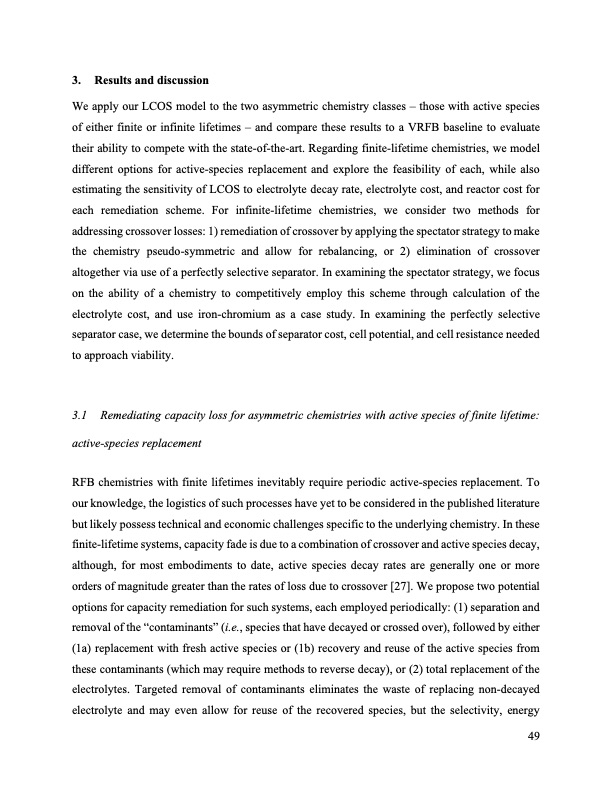
PDF Publication Title:
Text from PDF Page: 049
3. Results and discussion We apply our LCOS model to the two asymmetric chemistry classes – those with active species of either finite or infinite lifetimes – and compare these results to a VRFB baseline to evaluate their ability to compete with the state-of-the-art. Regarding finite-lifetime chemistries, we model different options for active-species replacement and explore the feasibility of each, while also estimating the sensitivity of LCOS to electrolyte decay rate, electrolyte cost, and reactor cost for each remediation scheme. For infinite-lifetime chemistries, we consider two methods for addressing crossover losses: 1) remediation of crossover by applying the spectator strategy to make the chemistry pseudo-symmetric and allow for rebalancing, or 2) elimination of crossover altogether via use of a perfectly selective separator. In examining the spectator strategy, we focus on the ability of a chemistry to competitively employ this scheme through calculation of the electrolyte cost, and use iron-chromium as a case study. In examining the perfectly selective separator case, we determine the bounds of separator cost, cell potential, and cell resistance needed to approach viability. 3.1 Remediating capacity loss for asymmetric chemistries with active species of finite lifetime: active-species replacement RFB chemistries with finite lifetimes inevitably require periodic active-species replacement. To our knowledge, the logistics of such processes have yet to be considered in the published literature but likely possess technical and economic challenges specific to the underlying chemistry. In these finite-lifetime systems, capacity fade is due to a combination of crossover and active species decay, although, for most embodiments to date, active species decay rates are generally one or more orders of magnitude greater than the rates of loss due to crossover [27]. We propose two potential options for capacity remediation for such systems, each employed periodically: (1) separation and removal of the “contaminants” (i.e., species that have decayed or crossed over), followed by either (1a) replacement with fresh active species or (1b) recovery and reuse of the active species from these contaminants (which may require methods to reverse decay), or (2) total replacement of the electrolytes. Targeted removal of contaminants eliminates the waste of replacing non-decayed electrolyte and may even allow for reuse of the recovered species, but the selectivity, energy 49PDF Image | Bringing Redox Flow Batteries to the Grid

PDF Search Title:
Bringing Redox Flow Batteries to the GridOriginal File Name Searched:
Rodby-krodby-phd-chemE-2022-thesis.pdfDIY PDF Search: Google It | Yahoo | Bing
Salgenx Redox Flow Battery Technology: Salt water flow battery technology with low cost and great energy density that can be used for power storage and thermal storage. Let us de-risk your production using our license. Our aqueous flow battery is less cost than Tesla Megapack and available faster. Redox flow battery. No membrane needed like with Vanadium, or Bromine. Salgenx flow battery
| CONTACT TEL: 608-238-6001 Email: greg@salgenx.com | RSS | AMP |